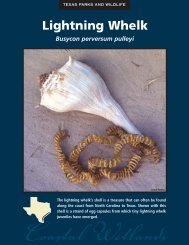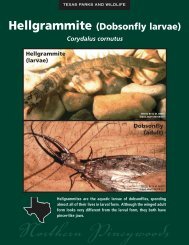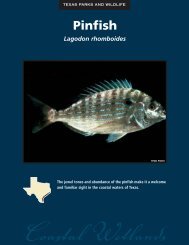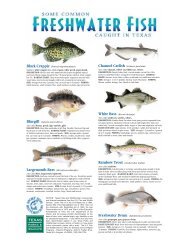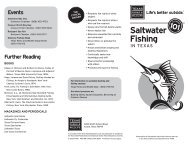Flathead Catfish - The State of Water
Flathead Catfish - The State of Water
Flathead Catfish - The State of Water
You also want an ePaper? Increase the reach of your titles
YUMPU automatically turns print PDFs into web optimized ePapers that Google loves.
TEXAS PARKS AND WILDLIFE<br />
<strong>Flathead</strong> <strong>Catfish</strong><br />
Pylodictis olivaris<br />
TPWD PHOTO<br />
As the common name suggests, this catfish has a flat head, but<br />
other than that, it looks like any other catfish: it has smooth,<br />
scaleless skin, whisker-like barbels around the mouth, and long,<br />
sharp spines on the dorsal (back) fin and one on each side <strong>of</strong> the<br />
pectoral (shoulder) fin.
<strong>Flathead</strong> <strong>Catfish</strong><br />
Pylodictis olivaris<br />
APPEARANCE<br />
Length: 3 to 4 feet (0.9 to 1.2 m)<br />
Weight: Can exceed 100 pounds (45 kg)<br />
Distinguishing Characteristics<br />
• Olive-yellow to light brown body sometimes marked with<br />
dark specks or blotches<br />
• Belly is paler than the body.<br />
• Large mouth with protruding lower jaw<br />
• Eight barbels surround the mouth – four below the mouth,<br />
two above the mouth and one on each side <strong>of</strong> the mouth.<br />
• Square caudal (tail) fin<br />
LIFE HISTORY<br />
Range:<br />
Diet:<br />
Predators:<br />
Sexual maturity:<br />
Spawning season:<br />
Nests:<br />
Eggs:<br />
Incubation:<br />
Young:<br />
Life span:<br />
From the lower Great Lakes through the<br />
Mississippi River watershed to the Gulf<br />
states<br />
Young feed mostly on invertebrates such<br />
as worms, insects and crayfish. When<br />
10 inches or larger, their diet consists<br />
entirely <strong>of</strong> fish–shad, carp, suckers, sunfish,<br />
largemouth bass and other catfish<br />
(including their own kind).<br />
Alligators, water snakes, turtles, larger<br />
fish, and humans<br />
Between the third and sixth year<br />
Late May through August when the<br />
water temperature is between 75º and<br />
80º F<br />
Males select hollow logs, caves or areas<br />
beneath the banks for their nest sites.<br />
Males may even improve their selected<br />
sites by creating shallow depressions for<br />
the females to lay their eggs.<br />
Number varies greatly depending on<br />
female size, but average is up to<br />
100,000 eggs at a time.<br />
Four to six days<br />
<strong>The</strong> fry (very young fish) will school<br />
together at the nest for several days<br />
after hatching; afterwards they will seek<br />
shelter beneath rocks, roots and other<br />
cover and begin their independent lives.<br />
Average is 12 to 14 years, but one<br />
recorded flathead catfish lived 24 years.<br />
HABITAT<br />
<strong>Flathead</strong> catfish prefer deep pools <strong>of</strong> streams, rivers, canals,<br />
lakes and reservoirs, where the water is turbid (cloudy) and the<br />
currents are slow.<br />
BEHAVIOR<br />
Adults are usually solitary, each staking out a favorite spot<br />
under a tree or in a cove, in deep water. At night, they move<br />
into shallow areas to feed. Males defend their nest and eggs<br />
aggressively. <strong>The</strong>y will fan the nest with their tails to keep the<br />
eggs clean and provide them with oxygenated water. If females<br />
have been eating poorly, their bodies may conserve resources by<br />
not releasing eggs. Poor overall health and certain environmental<br />
conditions such as drought or flood can reduce flatheads’<br />
ability to spawn. In healthy times, clutches can reach 100,000<br />
eggs, but only a small number will survive.<br />
NOW YOU KNOW!<br />
• <strong>Catfish</strong> have long, sharp spines on the front edges <strong>of</strong> their<br />
dorsal fins that are connected to venomous glands. Although<br />
the spines can tear skin, the glands excrete venom. <strong>The</strong><br />
venom is irritating and some people have had serious problems<br />
with infection afterward. (If you are “stung” by a catfish<br />
and are worried about it, please call your doctor.)<br />
• Scientists estimate that a female will lay 1200 eggs for every<br />
pound she weighs. A female flathead that weights 50 pounds<br />
might release 60,000 eggs at a time.<br />
• Pylodicitis is Greek for “mud fish.” Olivaris is Latin for<br />
“olive-colored.” <strong>Flathead</strong> catfish are known by other names<br />
as well–yellow cat, opelousa cat, pied cat and Mississippi cat.<br />
• Unlike other catfish which are scavengers, flatheads prey<br />
only on live fish.<br />
FLATHEAD CATFISH AND<br />
PEOPLE<br />
In size, flatheads are the second largest sport fish in Texas after<br />
their cousin, the blue catfish. Among those who selectively fish<br />
for catfish, flatheads fall just behind channel catfish as a prized<br />
species. Because <strong>of</strong> their popularity with anglers, they have<br />
been introduced in many other states where they have adapted<br />
well. In some cases, however, they have out-competed the<br />
native fish species, causing those native fish populations to<br />
decline sharply, disrupting some natural ecological processes.<br />
PWD LF D0200-848E (8/02) NOTICE: Texas Parks and Wildlife Department receives federal financial assistance from the U.S. Fish and Wildlife Service. Under Title VI <strong>of</strong> the Civil Rights Act <strong>of</strong> 1964, Section 504 <strong>of</strong> the Rehabilitation<br />
Act <strong>of</strong> 1973, Title II <strong>of</strong> the Americans with Disabilities Act <strong>of</strong> 1990, the Age Discrimination Act <strong>of</strong> 1975, and Title IX <strong>of</strong> the Education Amendments <strong>of</strong> 1972, the U.S. Department <strong>of</strong> the Interior and its bureaus prohibit discrimination<br />
on the basis <strong>of</strong> race, color, national origin, age, disability or sex (in educational programs). If you believe that you have been discriminated against in any Texas Parks and Wildlife Department program, activity, or facility, or if you<br />
desire further information, please call or write: <strong>The</strong> U.S. Fish and Wildlife Service, Office for Diversity and Civil Rights Programs - External Programs, 4040 N. Fairfax Drive, Webb 300, Arlington, VA 22203, (703) 358-1724.





